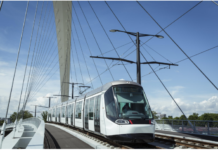Introduction
The Meerut City is located in the western region of Uttar Pradesh, India, approximately 80 kilometres northeast of New Delhi and 480 kilometres west of Lucknow. Commonly referred to as the “Sports City of India,” Meerut is one of the largest producers of sports equipment in the nation. Additionally, the city is recognised as the foremost producer of musical instruments in India and ranks among the largest gold markets in Asia. Meerut also serves as an educational hub within Western Uttar Pradesh, contributing to the region’s development and knowledge economy.
As of 2024, Meerut ranks as the 34th most populous city in India and holds the distinction of being the second most populous city within the National Capital Region (NCR), following Delhi. Meerut has seen immense development over the last several decades. With an ever-growing population and growing traffic, the transportation infrastructure of the city has become strained.
The Meerut Metro project aims to overcome these challenges by providing a new, secure, and green mode of transportation that suits the daily commuter and minimises the use of personal vehicles.
The metro network is planned to be integrated with the Regional Rapid Transit System (RRTS) between Delhi and Meerut. This integration will help improve regional connectivity, making Meerut a part of the National Capital Region (NCR) in economic and social development.
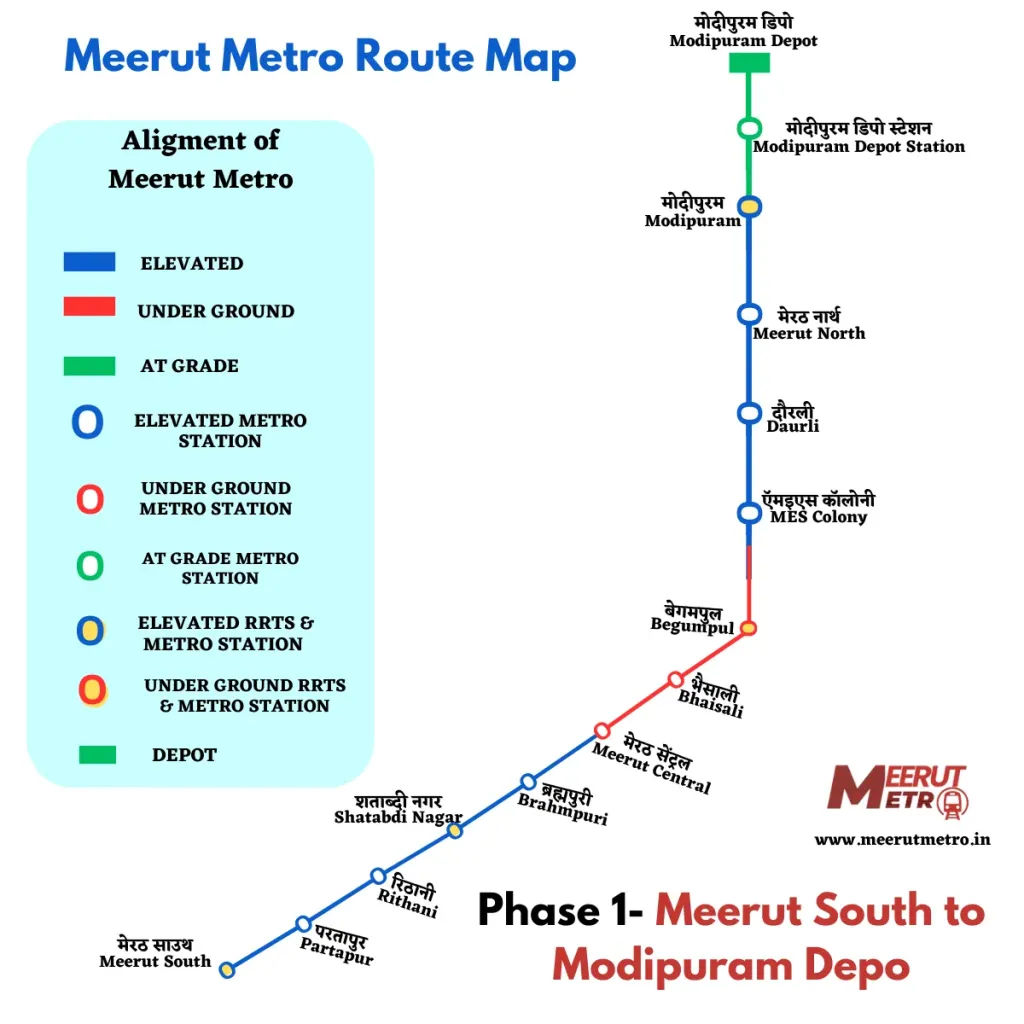
Meerut Metro: From Vision to Reality
Early 2020: The Government of India and the Uttar Pradesh State Government proposed the metro system for Meerut along with the Delhi-Meerut RRTS Project.
2015: RITES conducted the feasibility study for the Meerut Metro Project.
30 June 2016: RITES prepared the Detailed Project Report (DPR) of the Meerut Metro Phase 1 and submitted it to the state government of Uttar Pradesh for approval.
2017: The Uttar Pradesh Metro Rail Corporation (then Lucknow Metro Rail Corporation) was assigned a ‘coordinator’ role to bring all stakeholders together for the implementation of the project.
8 March 2019: Prime Minister Narendra Modi laid the foundation stone for the Meerut Metro Project along with the RRTS Project.
June 2019: Construction finally began for the Meerut Metro Project and Delhi-Meerut RRTS Project. ‘
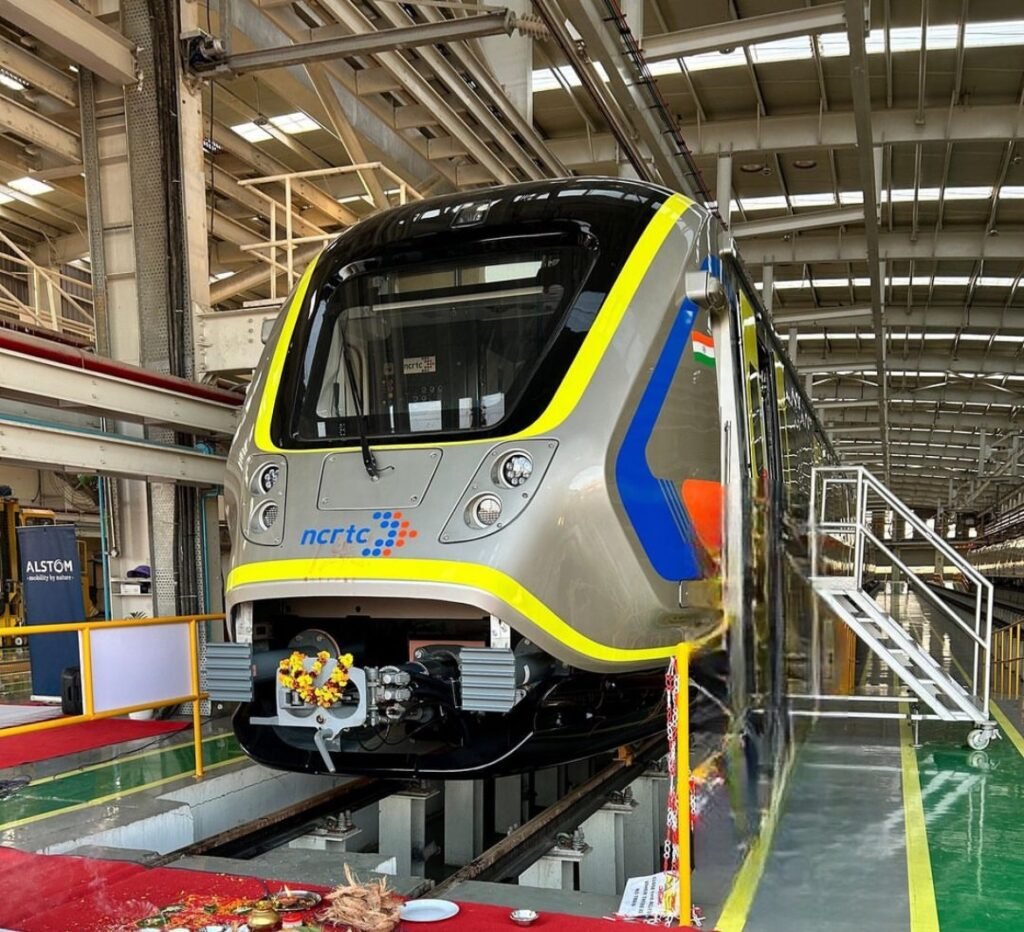
Meerut Metro: A New Era of Metro Connectivity
Overview
- Meerut Metro Project is an under-construction urban Mass Rapid Transit System (MRTS) for Meerut, Uttar Pradesh.
- The Meerut Metro project will be executed in 2 Phases.
- Phase 1 of the Meerut Project consists of one corridor spanning 20 km. The Meerut Metro Phase 1 will utilise the Delhi-Meerut RRTS Projects infrastructure and will be managed by the National Capital Region Transport Corporation (NCRTC).
- The Phase 2 of Meerut Metro Project is in the proposal stage currently and consists of one corridor.
- Phase 2 of Meerut Metro Project is expected to be built and operated by the Uttar Pradesh Metro Rail Corporation Limited (UPMRCL).
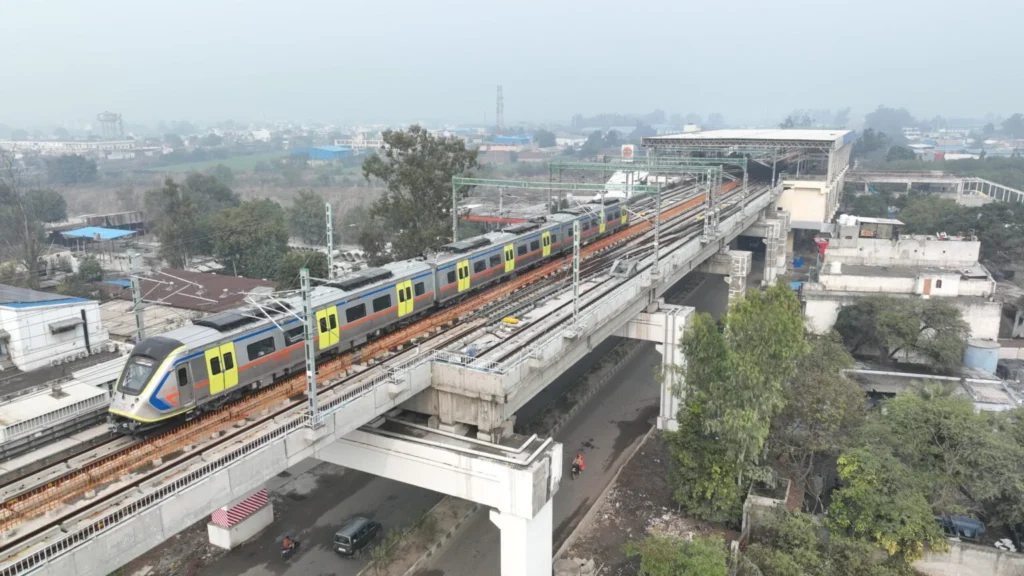
Rolling Stock
- In mid-2021, Alstom bagged the Rs. 2577 crore Rolling stock contract. As per the Contract, Alstom was supposed to supply 10 trainsets, each consisting of 3 coaches, to NCRTC for the Meerut Metro Project.
- In February 2024, Alstom supplied the first 3 coach trainsets for the Meerut Metro Project.
- Alstom has supplied all 10 train sets for the Meerut Metro Project to the NCRTC as per the contract. Currently, All the train sets supplied by Alstom are housed at Duhai Depot, as the Modipuram Depot is still under construction.
India’s Fastest Metro: Speed, Capacity, and Indigenous Manufacturing
What distinguishes the Meerut Metro from the rest of the urban transport networks in India is its high speed. It is going to be the fastest in the nation, with trains having a design speed of 135 kmph and an operating speed of up to 120 kmph.
In keeping with the ‘Make in India’ policy, 100% of the Meerut Metro trainsets are being domestically produced, which strengthens the country’s vision to be self-reliant in infrastructure development.
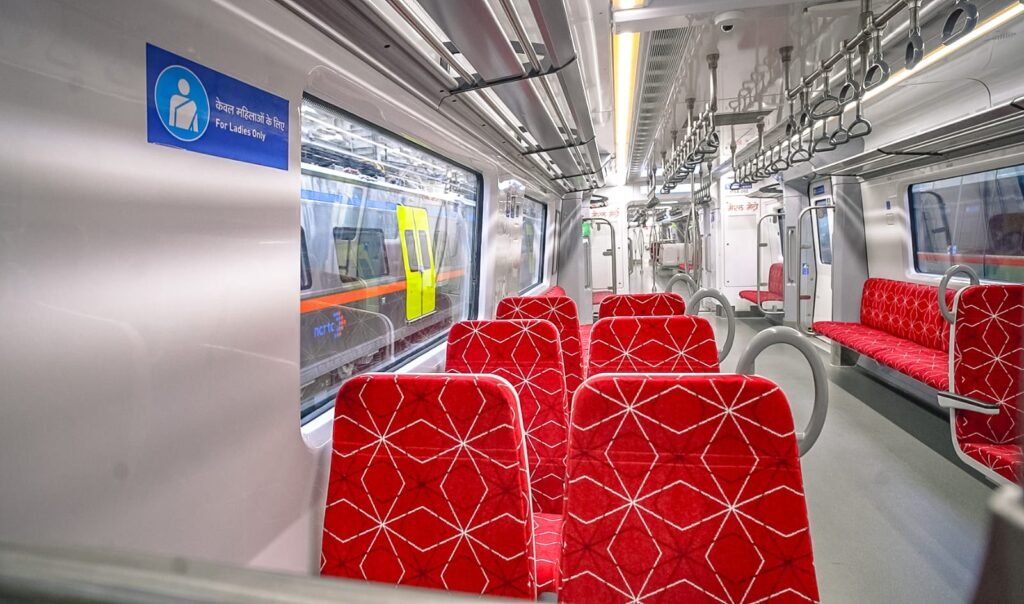
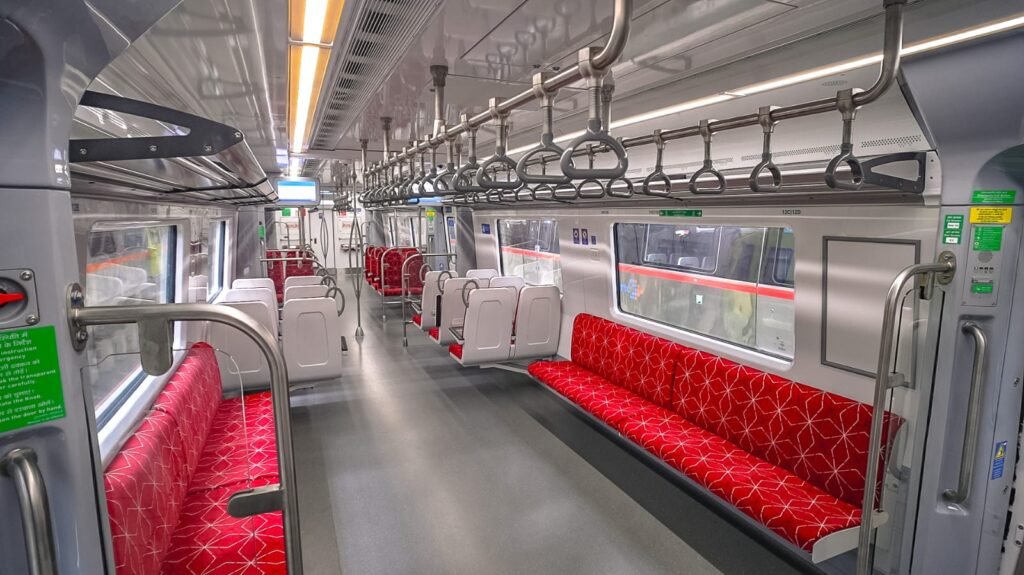
Contractor List
| Contract | Contractor |
| General Consultant (GC) for RRTS & Metro Project | Ayesa lngenieria Y Arquitectura – ITALFERR – Ayesa India (AIAI) |
| Rolling Stock: Supply of 30 coaches as part of 210 RRTS rolling stock contract | Alstom Transport |
| Part of Package-3: Partapur – Shatabdi Nagar (elevated viaduct and 3 stations at Partapur, Rithani, & Shatabdi Nagar) | Larsen & Toubro (L&T) |
| Package-5B: Modipuram Depot & Workshop | KSM Bashir Mohammad & Sons |
| Package-7: Shatabdi Nagar – Brahampuri DN Ramp AND Begumpul Ramp – Modipuram (elevated viaduct and 5 stations at Brahmapuri, MES Colony, Daurli, Meerut North and Modipuram) | Larsen & Toubro |
| Package-8: Brahampuri DN Ramp to Begumpul UP Ramp (underground twin tunnels and 3 stations at Meerut Central, Bhaisali and Begumpul) | Afcons Infrastructure |
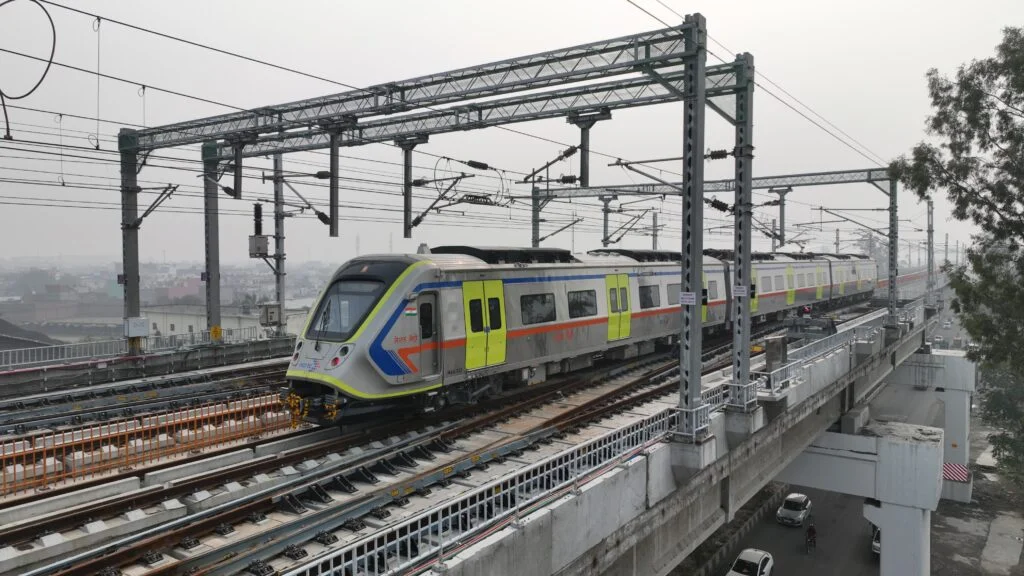
Route Information
| Operational: 0 km Under Construction: 20 km Proposed: 15 km |
Phase 1
Line-1: Partapur – Modipuram
- Length: 20 km
- Status: Under Construction
- Type: Elevated: 14.40 km & Underground: 5.6 km
- Depot: Modipuram Depot
- Number of Stations: 13
- Station Names: Partapur, Rithani, Shatabdi Nagar, Brahmapuri, Meerut Central, Bhaisali, Begum Pul, MES Colony, Daurli, Meerut North, Meerut South, Modipuram and Modipuram Depot.
| Recent Update on Phase 1 Trial Runs In January 2025, NCRTC initiated trial runs on the 9.4 km route spanning from Meerut South Station to Meerut Central Station, featuring 6 stations. The NCRTC team operated the 3-coach Alstom train on the 9.4 km stretch. |
Phase 2
Line-2: Shradhapuri Phase II – Jagriti Vihar
- Length: 15 km
- Owner: Uttar Pradesh Metro Rail Corporation Limited (UPMRCL
- Status: Proposed
- Type: Elevated (10.7 km) and Underground (4.3 km)
- Number of Stations: 13
- Station Names: Sharadhapuri Phase 2, Kanker Khera, Meerut Cantt. Railway Station, Rajban Bazar, Begumpul, Baccha Park, Shahpeer Gate, Hapur Adda Chauraha, Gandhi Ashram, Mangal Pandey Nagar, Tej Grahi, Medical College, Jagruti Extension
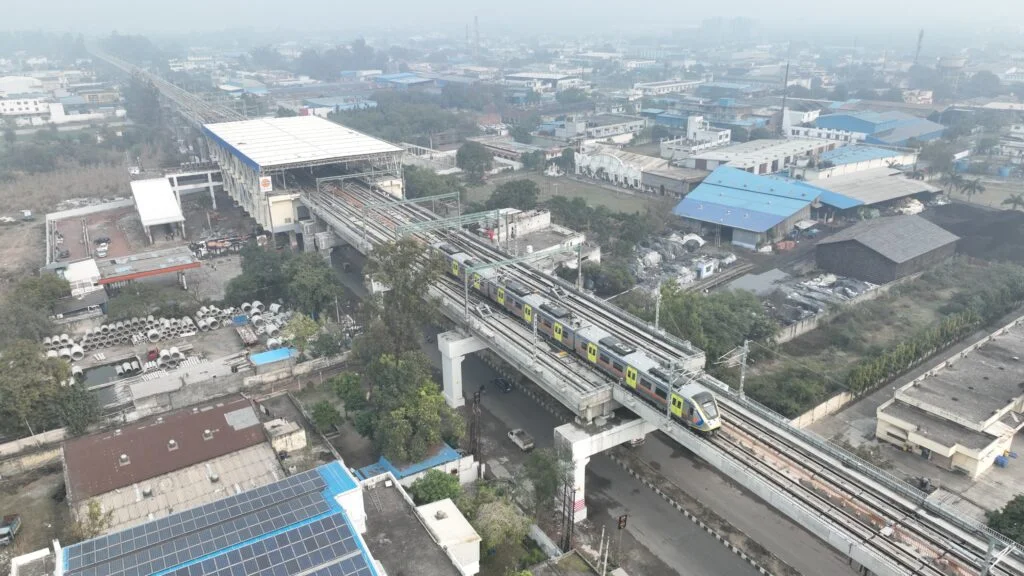
Integration With Delhi- Meerut RRTS Project
The Meerut Metro Project has been engineered to integrate with the Delhi-Meerut Regional Rapid Transit System (RRTS).
Key Aspects of Integration:
Shared Infrastructure: A substantial portion of the Meerut Metro will function on the same infrastructure as the Delhi-Meerut RRTS corridor within the city of Meerut. This includes the tracks, elevated viaducts, and several stations.
Common Stations: Four stations Meerut Metro Project will serve as interchange points between the Meerut Metro and the Delhi-Meerut RRTS:
- Meerut South
- Shatabdi Nagar
- Begumpul
- Modipuram
The integration of the Meerut Metro Project along with the Delhi- Meerut RRTS aims to provide commuters with effective local transit options within Meerut, along with rapid regional connectivity to Delhi and other areas of the National Capital Region (NCR).

Recent Update on the Meerut Metro Project
| Begumpul Station Near Completion The Begumpul station of Meerut Metro, which also serves as an interchange for the Delhi-Meerut RRTS project, is near completion. NCRTC CPRO Puneet Vats mentioned, “Tracks for both up and down lines are laid, and the station is in its final construction phase. Begumpul will be Meerut’s only underground station serving both Namo Bharat and Metro commuters. This is India’s first infrastructure project where two transit systems will share the same track, with two platforms and four railway tracks catering to the Rapid Rail Transit Corridor and the city’s intercity metro.” |
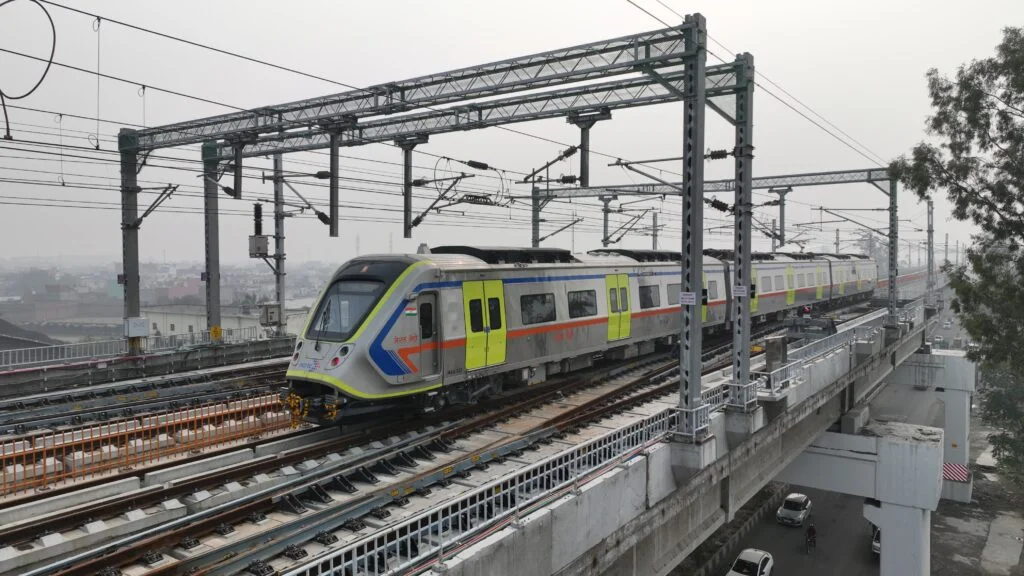
Impacts of the Meerut Metro Project
1. Enhanced Connectivity: The Meerut Metro will improve urban mobility within the city by establishing seamless connections to the National Capital Region (NCR). As an integral part of the Regional Rapid Transit System (RRTS), it will link crucial areas such as Modipuram and Partapur, while also integrating with rapid transit lines extending into the core of Delhi.
2. Reduction in Traffic Congestion: Meerut is currently facing severe traffic congestion, primarily due to the excessive number of private vehicles on its roads and the limited availability of reliable public transportation options. The introduction of the metro system will offer a streamlined and efficient alternative, alleviating the traffic on roads.
3. Economic Growth: The enhanced connectivity by Meerut Metro is anticipated to stimulate economic activity throughout the region. By facilitating improved access to employment opportunities, markets, and educational institutions, the metro will empower local residents and attract new investments.
4. Environmental Benefits: The transition toward a comprehensive public transport system represents a crucial step in reducing the dependence on private vehicles, which, in turn, is expected to lead to a substantial decline in carbon emissions.
Conclusion
The Meerut Metro Project signifies a pivotal advancement in addressing the urban mobility challenges confronted by one of the rapidly developing cities in Uttar Pradesh. Strategically integrated with the Delhi-Meerut Regional Rapid Transit System (RRTS), this metro initiative aims to establish an efficient, and environmentally sustainable public transportation network. By enhancing connectivity, alleviating traffic congestion, fostering economic growth, and contributing to ecological sustainability, the project possesses substantial potential to transform Meerut’s urban framework. As construction advances and Phase 1 approaches operational readiness, the Meerut Metro is prepared to initiate a new era of mobility and sustainable urban development.



